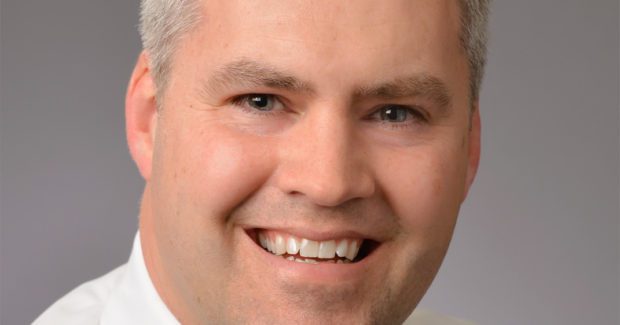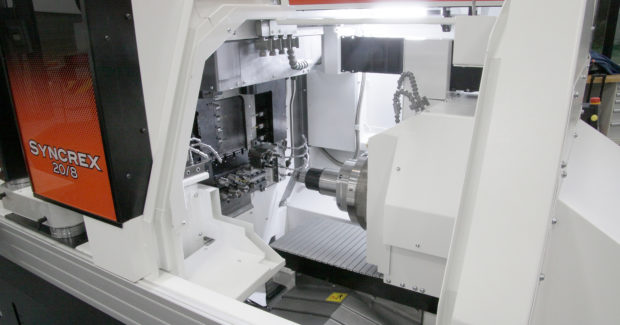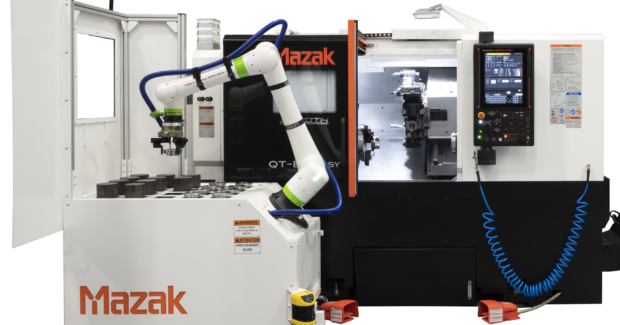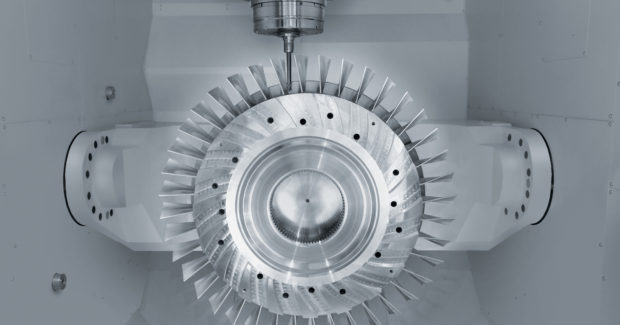Mazak Corp.’s Innovations Tackle Changes to Ensure Customer Success
Mazak’s continuous investments into the development of new products ensures the company is not only a machine tool manufacturer but a total solutions provider.
Posted: June 17, 2022
Severe disruptions to the manufacturing sector in the past have ushered in momentous change, and the COVID-19 pandemic is a reminder that when things eventually settle down, the sector will function differently than it did before.
“This is an important time to invest, not only because of pent up demand but because of the changes in our industry: high prices, lack of material and labor, and constraints of the supply chain,” said Chuck Birkle, vice president of sales and marketing, Mazak Corp.
Birkle described the changing landscape: “We had a customer in yesterday in Florence, Ky. [North American manufacturing headquarters]. He is a third-generation shop; and he is looking at a bunch of machines, and he said: ‘Chuck, if I buy the same types of machines as we did in the past I could be out of business.’ And he is doing the same types of parts.”
For Mazak, a leader in the design and manufacture of machine tool solutions, working together with its customers to overcome challenges means both organizations will achieve success and grow together. Mazak offers advanced technology solutions including multitasking, hybrid multitasking, 5-axis, milling, turning, and advanced CNC controls and automation. There are five levels of multitasking machines to meet specific needs.
Mazak’s major machine tool technologies continue to move the manufacturing sector forward. Innovations include technologies that respond to changes in materials, which range from extremely hard materials such as super alloys to complex applications that are printed to lighter materials such as those applications that reduce the weight of parts.
“We are seeing thinner, lighter, smaller types of parts, and we are seeing more specialized parts on the other end,” said Greg Papke, vice president of sales and marketing, Mazak. “So, you have the hybrid [machine] side to address some of that on one end. And then you have Swiss and multitasking [machines], whether it is INTEGREX [multitasking machine] or VARIAXIS [5-axis machine], to address it on the other end.”
Ready for the Future
As job shops position themselves to navigate the changes in materials and other factors many have been investing in machinery and implementing changes within their processes and operations. Shops are seeking easily deployable automation solutions to produce parts with as few steps as possible.
Machine tool manufacturers have stepped up and eliminated a number of steps in the manufacturing process, which includes Mazak. For example, Mazak offers the DONE IN ONE concept which offers short part cycle times, machine accuracy and increased capacity, all in one machine. The upper turret works on a part in the machine’s main spindle while the lower turret works on a part in the second spindle.
“One of things, at least from the Midwest region, we are seeing a lot of customers look for is more multitasking solutions, which is simply another form of automation,” said Kevin Bates, regional general manager for Mazak’s Midwest Region. “The more you can do in one machine the fewer times you have to handle that part.”
The Mazak team has worked to lower the barriers to entry regarding multitasking machines so that two, three and four-man job shops have been embracing the advantages of the technology. This includes a versatile, user-friendly programming language that supports a wider range of production needs.
Since the introduction in 1981 of the MAZATROL programming language, all Mazak CNC systems offer conversational, or EIA/ISO, programming. With Mazak’s Smooth Controls, operators have the flexibility to select how they want to program, whether it is a quick setup for a single part, a program for a high production cycle time, or precise 5-axis contouring of parts that would be better served offline, Papke noted.
With Smooth Controls, the PC and NC sides are separated so there is enough horsepower for part programming simulations and such, but also the benefit of separating the NC side to avoid Windows-related crashes.
At Its Core
Mazak’s world-class facility Florence, Ky., has undergone nearly 20 expansions since it opened in 1974. Since the beginning of 2020 and throughout the pandemic, Mazak has made significant investments in both facilities’ expansions as well as manufacturing systems and automation.
Mazak invested more than $8.5 million in facilities’ expansions including a new Spindle Rebuild & Repair facility, a North American parts warehousing expansion and a new facility for the production of Mazak’s SYNCREX Swiss-style turning machines.
In addition, Mazak invested more than $17 million in its iSMART Factory in the form of new manufacturing systems and automation including a state-of-the-art manufacturing cell equipped with a fully automated storage and retrieval system and six advanced precision machine tools configured with Digital SMOOTH technology manufacturing solutions. The investment also included a modernization of its high precision grinding operation, the installation of a new Mazak FJW precision 5-sided portal mill and the integration of two new fully automated robotic welding cells.
Said Dan Janka, Mazak’s president, of the iSmart Factory: “As always, it has been our practice to first use any newly developed Mazak manufacturing technology in our own operations before ever offering it to customers.”
The 800,000-square-foot facility in Florence produces more than 100 models of turning centers, multitasking machines, and vertical machining centers, including 5-axis models. Mazak’s world headquarters is in Japan, which produces other machine models.
Mazak also has eight regional technology centers located throughout North America, as well as technical centers in northern California, Orlando, Fla., Dallas, Provo, Utah and Edmonton, Alberta, Canada to provide fast and reliable applications expertise, service and more.
Regarding the technology centers, Birkle stated that if Mazak is going to walk customers down a new path, for example with a new way to make landing gear, it must show concepts “in our technology centers.”
Mazak’s machine tool solutions include the flagship of the multitasking family: the INTEGREX, Birkle added. “The new generation of INTEGREX’s have a tremendous torque in the milling spindle and they have high RPMs,” he said.
For one manufacturer of aircraft wheels and brakes, the installation of four INTEGREX machines enabled the company to produce everything in one building, reducing its operations down from 27 buildings and 15 operations.
Further, Mazak continues to respond to customer requests by adding more capabilities to its multitasking machines. The hybrid multitasking machines include innovative joining and additive manufacturing solutions such as friction stir welding, hot wire deposition and multi-laser metal additive manufacturing. “So, while we have that part chucked people want to grow a feature on it or do some friction stir welding or hot wire laser deposition while the part is being produced in one setup,” Birkle noted. “Workpieces that have a certain complexity to them, either in their design or their materials or IP; these parts tend to be prime for not only multitasking but multitasking with hybrid capability.”
Another new initiative is an all-new line of SYNCREX Swiss-style machines, which debuted at the company’s DISCOVER 2021 event. The SYNCREX models feature 7-, 8- and 9-axis configurations that are ideal for high-production of small parts. SYNCREX machines accommodate a maximum of 36 tools in a standard configuration: The Y-axis back working tool post is interchangeable between static and live holders. This configuration allows for 20-to-26 static stations, and 10-to-16 live stations for a total capacity of 36 tools.
An exclusively designed automated tool setter checks, measures and sets up tools to optimize the process, allowing job shops to reduce setup times from days to hours.
“The SYNCREX machines are built on our High Damping Composite Casting (HDCC) which helps achieve better part surface finishes, longer tool life, and overall tighter tolerances on the machines,” Bates said. “At IMTS this year we will have machines ranging from 20-to-38 mm and each machine will be available in a 7-, 8- or 9-axis model. The 9-axis model will have full B-axis contouring so it gets into the high end one multitasking DONE IN ONE, which is automated with the use of a bar feed.”
The VARIAXIS series of machines is another product line suited toward job shops and medium-sized production facilities, especially where operators will be conducting a high amount of change over on their machines. The VARIAXIS machines will also be on display at IMTS 2022, where the company will have a 17,000-square-foot booth.
Among this series is the VARIAXIS C-600, a 5-axis machining center. Bates said the product is offered with an optional mill assist robot loading package “where we can robot load through the side door of the machine. We offer integrated pneumatics or hydraulics through the table for clamping on the workpiece — so a prepackaged automation solution with a very user-friendly operator interface.” The other automated solution Mazak offers on the VARIAXIS C600 is a Multi-Pallet Pool (MPP), which also loads through the side door of the machine.
Yet another series of machines attractive to small and medium-sized operations is the Ez series, which are entry level vertical machine centers and quick turn machine centers, Papke pointed out.
“Basically, we took an existing product and redesigned them to utilize the same designs with integral spindles and so forth, but we changed the control architecture to what we call SMOOTH-Ez Control,” Papke said. “It is non-PC based; so, it is an NC type control with 15-inch touch screen, nice graphics interface.” The electrical composition was lowered from 400-volt to 200-volt, which lowers the price. The sheet metal enclosure is smaller, creating a more compact footprint which is easier to install and move around.
“So, you get the same productivity levels of our prior generation machines but at a much lower cost,” Papke notes.
Mazak is committed to supplying the best and relevant products in the industry and pushing the envelope as far as automation and different technologies. “It is all encompassing when it comes to Mazak,” Bates said. “Not just the machine technology — it is all the support and the structure behind it that is able to support our customers.”
Birkle added that it is one thing for customers to be satisfied with the company’s machines and service, but if products don’t keep up with advances in materials and cut down on steps in the production process, customers will look elsewhere. “That is why you see this tremendous initiative by us to develop new products,” he said.
Empowering Customers Through MPower
Last year the Mazak Corp. moved the needle on customer care. The MPower support program is Mazak’s single-source, end-to-end customer support for the life of every machine. Features of the program include fast and accurate replacement parts ordering and service scheduling as well as direct access to other benefits. This includes support from Mazak’s network of technology and technical centers, and access to spindle repair services. Additionally, MPower includes remote assist services, and on-demand training where companies can train from anywhere and avoid traveling to a training site.
With the remote assist service, a Mazak coordinator views a customer’s issue through a smart device video call. At that time, the coordinator determines if a technician needs to be sent out to the customer’s site or if the issue can be solved during the call, said Jason Fights, national service manager, Mazak. As a result of the remote assist, if a technician is needed onsite they can hit the ground running because they know the procedure required to fix the machine and any parts required have been delivered to the site.
Fights said Mazak has seen an increase of customers request online training services. He said it is reassuring that the manufacturing sector is starting to tap into the digital tools regarding training, service and maintenance.
What’s next regarding digital tools used with machine tools? Fights pointed out the advancements regarding predictive maintenance software, which positions manufacturers to schedule maintenance time before machines fail, for example, in the middle of a parts cycle.
“Once those technologies become available [it] is going to be really interesting to see because now you can start planning things much better than what we are doing now,” Fights said.
Mazak’s Technology Centers More Than “Demo Rooms”
Manufacturing technology centers are commonly known as demonstration rooms, a phrase Mazak’s team doesn’t use because it implies the presentation given to job shop owners is a preprepared demo. Mazak doesn’t show only the features they want customers to see regarding their machines but instead pushes the envelope on what the machines can do.
“There is a limit of what you can do when you do that, but I would say about half of the machines on our technology center floor right now are set up doing test cuts for customers,” said Kevin Bates, regional general manager for Mazak’s Midwest Region. “And that is working hand-in-hand with not only our customers and our applications engineers, but with fixture and tooling companies. We all come together as a collaborative effort to come up with the best solution for the customer.”
The technology center applications engineers work with unique applications and materials and have had success with customers changing over to multitasking machines because they offer the best solutions.
“We never ask our customers to do what we are not willing to do ourselves first in our own factory,” said Chuck Birkle, vice president of sales and marketing, Mazak. “We can’t be viewed as just a machinery maker; we have to be viewed as a total solutions provider.”
Subscribe to learn the latest in manufacturing.
























